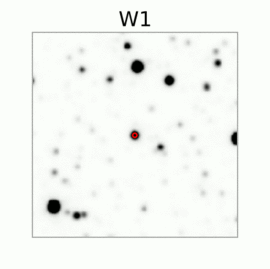Astronomy:WISEA J120037.79-784508.3
| Observation data Equinox J2000.0]] (ICRS) | |
|---|---|
| Constellation | Chamaeleon |
| Right ascension | 12h 00m 37.712s[1] |
| Declination | −78° 45′ 08.378″[1] |
| Astrometry | |
| Proper motion (μ) | RA: -41.664 [0.080][1] mas/yr Dec.: -6.050 [0.074][1] mas/yr |
| Parallax (π) | 9.8383[1] ± 0.0714[1] mas |
| Distance | 333.73 ± 3.13[2] ly (102.32 ± 0.96[2] pc) |
| Details | |
| Mass | 42–58[2] MJup |
| Luminosity (bolometric) | 0.078[2] L☉ |
| Temperature | Teff, BD = 2784–2850[2]K |
| Metallicity | 0.7998 Fe abundance (from GSP using BP/RP spectra)[1] |
| Age | 3.7+4.6−1.4[2] Myr |
| Database references | |
| SIMBAD | data |
WISEA J120037.79-784508.3, also called W1200-7845 or 2MASS J12003792-7845082, is a brown dwarf with a primordial disk 333.73 ± 3.13 lightyears from Earth in the 3.7+4.6−1.4 Myr-old ε Chamaeleontis (ε Cha) association, currently making it the closest known brown dwarf with an associated circumstellar disk.[2] It was discovered by citizen scientists in 2020 volunteering for the Disk Detective project.[3]
Disk Detective's science team then cross-matched W1200-7845 with BANYAN Σ, a Bayesian analysis tool used to estimate the likelihood that an object is a member of a young moving group based on its position, proper motion, and parallax (using Gaia DR2 data, if available) and radial velocity. The analysis revealed (with 99.8% probability) that the brown dwarf was a member of the ε Cha young moving group association.[2][3]
Brown Dwarf
The brown dwarf has a mass of about 42-58 |♃|J}}}}}} and has a spectral type of about M6.0γ. The gamma (γ) signifies the low surface gravity of the object, which is typical for young brown dwarfs. No accretion was detected from paschen and brackett spectral lines.[2]
Later observations by Kubiak et al. 2021 found a strong H-alpha emission line, which indicates strong accretion of material. Named candidate #22 in their sample, it was the strongest accreting object in their entire sample.[4]
Disk
Three possible scenarios were considered for the disk: A blackbody disk (a disk with uniform temperature), two blackbody disks (a disk with a gap) and a power-law disk. The blackbody disk model has a temperature of 516 K (243°C; 469°F). The two-blackbodies model compromises of an inner disk with a temperature of 730 K (457°C; 854°F) and an outer disk with a temperature of 230 K (-43°C; -46°F). The best-fit model is a power-law disk with a power-law slope of α=-0.94, which is consistent with a class II disk. The close proximity of this system to the solar system makes this disk a good candidate to image the disk with ALMA.[2]
See also
- Cha 110913−773444
- Goddard Space Flight Center
- Wide-field Infrared Survey Explorer
- Disk Detective
- Backyard Worlds: Planet 9
- Citizen science
External links
- Disk Detective's Zooniverse blog at diskdetective.org
- Citizen scientists spot closest young brown dwarf disk yet from MIT News
References
- ↑ 1.0 1.1 1.2 1.3 1.4 1.5 1.6 Sarro, L. M.; Berihuete, A; Smart, R. L.; Reylé, C.; Barrado, D.; García-Torres, M.; Cooper, W. J.; Jones, H. R. A. et al. (2022). "Ultracool dwarfs in Gaia DR3 (from table in VizieR)". Astronomy and Astrophysics 669 (A193): 1–25. doi:10.1051/0004-6361/202244507. Bibcode: 2023A&A...669A.139S.
- ↑ 2.00 2.01 2.02 2.03 2.04 2.05 2.06 2.07 2.08 2.09 2.10 Schutte, Maria C.; Lawson, Kellen D.; Wisniewski, John P.; Kuchner, Marc J.; Silverberg, Steven M.; Faherty, Jacqueline K.; Gagliuffi, Daniella C. Bardalez; Kiman, Rocio et al. (2020-08-04). "Discovery of a Nearby Young Brown Dwarf Disk". The Astrophysical Journal 160 (4): 156. doi:10.3847/1538-3881/abaccd. ISSN 1538-3881. Bibcode: 2020AJ....160..156S.
- ↑ 3.0 3.1 Schutte, Maria (2020-08-12). "Our New Paper: Discovery of Nearby Young Brown Dwarf Disk!". https://blog.diskdetective.org/2020/08/12/our-new-paper-discovery-of-nearby-young-brown-dwarf-disk/.
- ↑ Kubiak, K.; Mužić, K.; Sousa, I.; Almendros-Abad, V.; Köhler, R.; Scholz, A. (2021-06-01). "New low-mass members of Chamaeleon I and ϵ Cha". Astronomy and Astrophysics 650: A48. doi:10.1051/0004-6361/202039899. ISSN 0004-6361. Bibcode: 2021A&A...650A..48K. https://ui.adsabs.harvard.edu/abs/2021A&A...650A..48K.
 |



